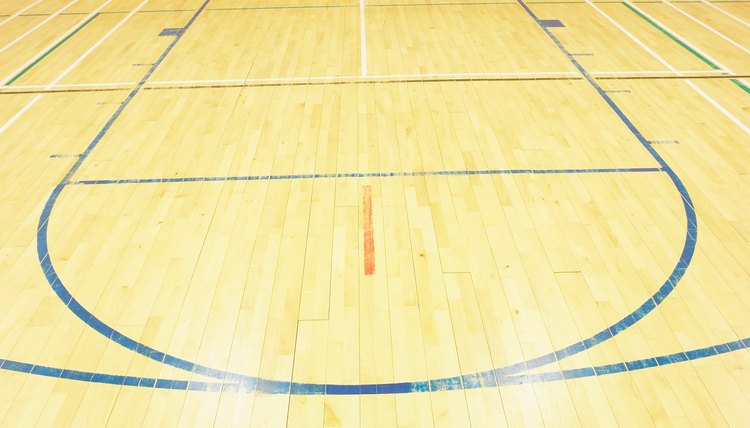Basketball Freethrow Rules

During a basketball game at nearly every level, a referee will eventually award free throws to a player. Free throws are worth one point each and players take them from a distance of 15 feet from the basket behind the “free-throw line," with no player allowed to defend the shot. Free throws, also called foul shots, occur after a defensive player fouls an opponent shooting at the basket by impeding him in any way. Free throws also result from other infractions. Specific rules cover the aspects of a free throw.
International Free-Throw Rules
The international game allows five players to position themselves along the “lane”--the area under the basket designated by lines that form a rectangle--during a free-throw attempt. The lane varies in width at different levels of the sport, with it wider under international rules than at the professional or college level. Two of the free-throw shooter’s own teammates may occupy a place in the lane, as well as three opponents. The players stand there to try to gain possession of any missed free throws, with the opponents of the shooter always given preference to occupy the spots closest to the basket on either side of the rim. Any player lined up in the spots designated along the lane must wait for the shooter to release the ball before crossing the lines on the court and venturing into the lane. Players not lined up along the lane must stay behind the shooter and cannot go after the ball until it hits the rim of the basket.
NBA and WNBA Free-Throw Rules
In a National Basketball Association contest or in a Woman’s NBA game, all of the spots marked on the lane closest to the basket must have a player occupying them. This means that two players must be on one side and at least two on the other side. The maximum amount of players allowed along the lane during an attempt is five—three opponents of the shooter and two teammates of the shooter. All players on the court can move when the shooter releases the free throw, but those on the lane cannot extend into the area directly in front of their opponents until the shooter lets go of the ball. For example, Player A cannot put his foot in front of opposing Player B to gain an advantage to grab a missed shot until the shot goes up. In the NBA and the WNBA, a player has 10 seconds to shoot the ball once the referee hands it to him or her. Violation of these rules can negate the free throw if committed by the shooting team or give the shooter another chance if made by the opposing team.
NCAA Free-Throw Rules
In a men or women’s National Collegiate Athletic Association game, six players can occupy the lane, with four opponents of the shooter and two teammates of the shooter allowed in to jockey for a potential rebound after a missed shot. An important difference between the men’s and women’s game is that the men must occupy the “blocks” nearest the basket, with opponents of the shooter in these two spots by rule. In the women’s version, the blocks closest to the basket are always left empty, with the players filling the rest of the blocks, all the way up to the fourth set of blocks that exist next to the shooter’s position behind the free-throw line. The shooter has 10 seconds to release the ball and players cannot leave their spots until the shooter lets go of the ball.
References
Writer Bio
John Lindell has written articles for "The Greyhound Review" and various other online publications. A Connecticut native, his work specializes in sports, fishing and nature. Lindell worked in greyhound racing for 25 years.
